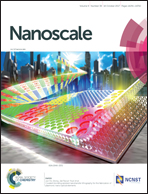FIB and MIP: understanding nanoscale porosity in molecularly imprinted polymers via 3D FIB/SEM tomography†
Abstract
We present combined focused ion beam/scanning electron beam (FIB/SEM) tomography as innovative method for differentiating and visualizing the distribution and connectivity of pores within molecularly imprinted polymers (MIPs) and non-imprinted control polymers (NIPs). FIB/SEM tomography is used in cell biology for elucidating three-dimensional structures such as organelles, but has not yet been extensively applied for visualizing the heterogeneity of nanoscopic pore networks, interconnectivity, and tortuosity in polymers. To our best knowledge, the present study is the first application of this strategy for analyzing the nanoscale porosity of MIPs. MIPs imprinted for propranolol – and the corresponding NIPs – were investigated establishing FIB/SEM tomography as a viable future strategy complementing conventional isotherm studies. For visualizing and understanding the properties of pore networks in detail, polymer particles were stained with osmium tetroxide (OsO4) vapor, and embedded in epoxy resin. Staining with OsO4 provides excellent contrast during high-resolution SEM imaging. After optimizing the threshold to discriminate between the stained polymer matrix, and pores filled with epoxy resin, a 3D model of the sampled volume may be established for deriving not only the pore volume and pore surface area, but also to visualize the interconnectivity and tortuosity of the pores within the sampled polymer volume. Detailed studies using different types of cross-linkers and the effect of hydrolysis on the resulting polymer properties have been investigated. In comparison of MIP and NIP, it could be unambiguously shown that the interconnectivity of the visualized pores in MIPs is significantly higher vs. the non-imprinted polymer, and that the pore volume and pore area is 34% and approx. 35% higher within the MIP matrix. This confirms that the templating process not only induces selective binding sites, but indeed also affects the physical properties of such polymers down to the nanoscale, and that additional chemical modification, e.g., via hydrolysis clearly affects that nature of the polymer.



 Please wait while we load your content...
Please wait while we load your content...